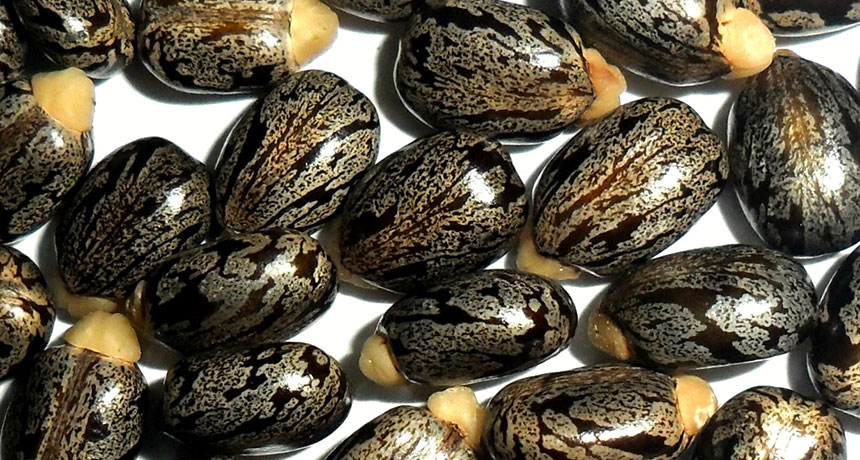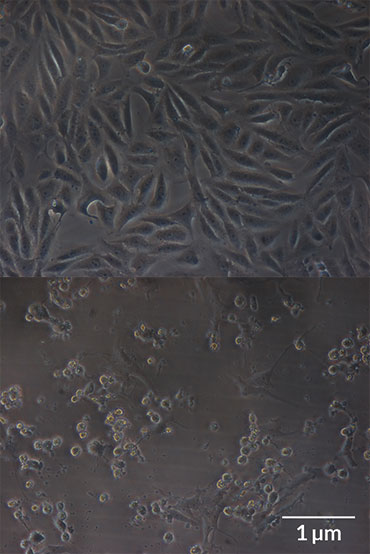Ricin poisoning may one day be treatable with new antidote
Blend of antibodies could neutralize toxic effects, tests in mice show

DANGEROUS BEANS The potent toxin ricin is found in castor beans (shown). No antidote exists for ricin poisoning, but a new antibody treatment that’s effective in mice could potentially help.
HediBougghanmi2014/Wikimedia Commons (CC BY-SA 3.0)
WASHINGTON — It has been used by an assassin wielding a poisoned umbrella and sent in a suspicious letter to a president.
Ricin, the potent toxin and bioterrorism agent, has no antidote and can cause death within days. But a cocktail of antibodies could one day offer victims at least a slim window for treatment.
A new study presented February 7 at the American Society for Microbiology’s Biothreats meeting reveals a ricin antidote that, in mice, works even days after exposure to the toxin. Another presented study offers a potential explanation for how such an antidote might work.
Doctors need some way to deal with ricin poisoning, said Patrick Cherubin, a cell biologist at the University of Central Florida in Orlando. Immunologist Nicholas Mantis agreed: “There is no specific treatment or therapy whatsoever.”
Though ricin has an innocuous origin (it’s found in castor beans), the poison is anything but harmless. It’s dangerous and relatively easy to spread — rated by the U.S. Centers for Disease Control and Prevention as a category B bioterrorism agent, just behind the highest-risk category A agents such as anthrax, plague and Ebola.
Ricin poisoning is rare but has featured in some high-profile cases. In 1978, Bulgarian writer Georgi Markov was hit in the thigh with a ricin-poisoned pellet shot from an umbrella gun. A few days later, he was dead. In 2013, a letter addressed to President Barack Obama tested positive for granules of the deadly toxin. A Texas woman had ordered castor bean seeds and lye online, for a do-it-yourself approach to making ricin. No one was injured.
Symptoms of ricin poisoning depend on how the toxin enters the body, and how much gets in. Inhaling ricin can make breathing so difficult the skin turns blue. Ingesting ricin can cause diarrhea, vomiting and seizures. Death can come as soon as 36 hours after exposure.
Ricin is known as an RIP — a scary-sounding acronym that stands for ribosome-inactivating protein, said Mantis, of the New York State Department of Health in Albany. In the cell, ribosomes serve as tiny protein factories. After ricin exposure, “the whole machinery comes to a screeching halt,” Mantis said. For cells, shutting down protein factories for too long is a death sentence.
Scientists have developed two vaccines for ricin, though neither is available yet for use in humans. A vaccine may be “good for soldiers going into the field,” said biochemist Ohad Mazor of the Israel Institute for Biological Research in Ness Ziona. But unvaccinated people are out of luck.

Even 48 hours after inhaling ricin, roughly 73 percent of mice, 22 out of 30, treated with the antibodies survived, the team reported at the meeting and in a paper published in the March 1 Toxicon. Untreated mice died within a week.
Previous antibody treatments for ricin work well only if mice are treated within hours after exposure, Mazor said. For poisoned humans, that may not be long enough to diagnose the problem. Mazor doesn’t know how his antibodies might work in people, but he’d like to follow up his mouse work with studies in monkeys or pigs.
Scientists haven’t figured out exactly how antibodies help animals recover, but another study presented at the meeting offers a clue. Cherubin and colleagues added ricin to monkey cells in a dish, and then tracked how much protein was manufactured by the cells.
At high enough levels, ricin exposure shuttered the factories as expected. But when researchers stopped exposing cells to the toxin, protein synthesis started up again and cells recovered. “You need ongoing toxin delivery to eventually kill the cell,” Cherubin said. It’s possible that antibody treatments could cut off ricin delivery to cells, letting them bounce back from poisoning, said study coauthor Ken Teter, also a cell biologist at the University of Central Florida.







